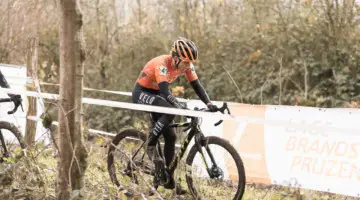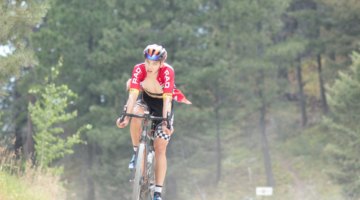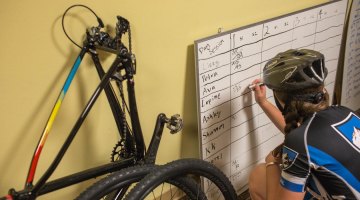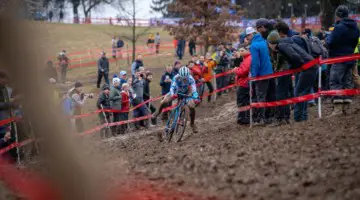Come next year, U.S. Cyclocross Nationals will be in the books by the time amateur cyclocrossers hit the holiday party scene. This year though, January Nationals are taking one last lap. This means one more year of training through the holidays for the country’s cyclocrossers hoping to hit the Stars-and-Stripes jackpot in Reno.
Although our Cyclocross Magazine team will likely never come close to a Nationals podium, we still had some questions about how to prepare for a target event that takes place a month after most riders are done racing in their local scenes. Throw in the holiday parties and the potential for illness and there are a lot of outside factors to manage.
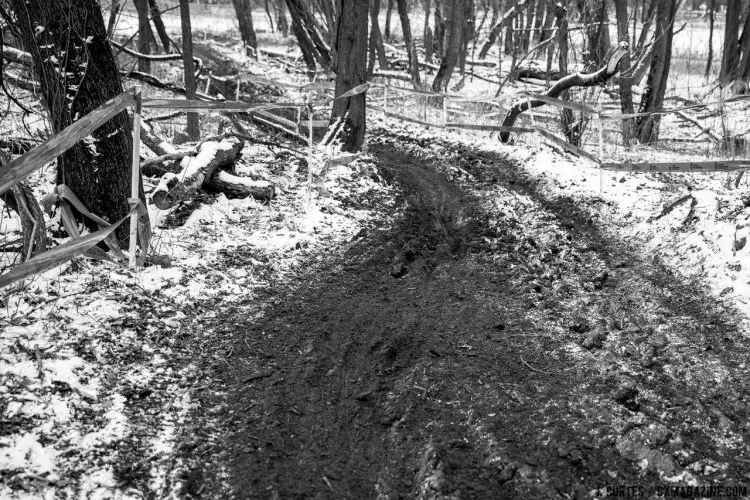
Cyclocross Nationals in January can bring all kinds of conditions. Will you be ready? 2017 Cyclocross National Championships. Sunday, U23 Men, Elite Women, Elite Men. © J. Curtes / Cyclocross Magazine
We reached out to some coaches to ask them for their advice on training through the holidays (or holidaze, as one of them called it) to be ready for Nationals. They offered advice on dealing with illness, being ready for the conditions and more. Not going to Nationals this year? They still have some great advice for training to ride in gnarly conditions, managing the excess of holiday parties and starting well in big, unfamiliar fields.
Our experts for this Ask the Coaches are Pennsylvania’s Chris Mayhew of JBV Coaching, who needs no introduction, North Carolina’s Brandon Davis of Wattage Cottage Coaching, who has also contributed to our Ask the Mechanics columns, and Kenneth Lundgren of Elite Endurance Coaching in New Jersey.
They offer a lot of knowledge, and sometimes some differing thoughts, so read on for more on how to peak for the last January Nationals and for tidbits you can use to target big events next season.
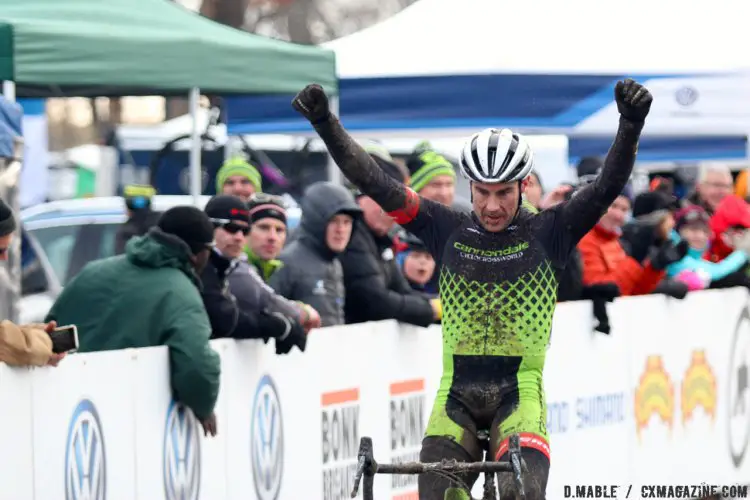
Our coaches want you to have your best possible race at Nationals (or any big race). Mathew Timmerman wins the 2017 Cyclocross National Championships Masters Men 40-44 race. © D. Mable / Cyclocross Magazine
Ask the Coaches: Nationals Prep and Late-Season Training
Cyclocross Nationals are known for having conditions ranging from dry to mud to snow. How do you advise clients practice riding mud and snow and other conditions they might not have locally?
Chris Mayhew: If it’s not raining, you’re not training. Any day the weather is sloppy, go work on cornering and handling. Worry about your fitness workouts somewhere else during the week. The same would apply for snow and ice. On days you’re blessed with bad conditions, go ride in the slop. If you live in southern Georgia or somewhere similar, then do the best you can and don’t worry too much about the specificity of the conditions you have to ride in. You can still hit singletrack and gravel and learn a lot.
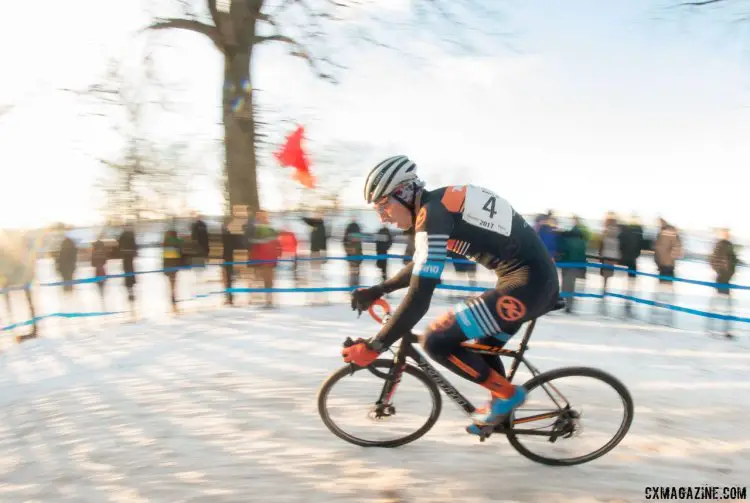
Snowy? Cold? Get out and ride and get some practice in! Kerry Werner at the 2017 Cyclocross National Championships, Elite Men. © A. Yee / Cyclocross Magazine
Kenneth Lundgren: I like to have athletes go out very early or late when there are slicker conditions. Start with 12-13% of body weight in psi for your tire pressure to get used to riding tubulars at pressures. They perform much differently and you must learn these limits and develop your proprioception to handle them. Once you relax and gain confidence, you will be amazed how much traction and speed is possible.
Also, ride at night. The eyes lie to you and create fear. You normally look to where you want to go, but at night you don’t see the loose dirt or ruts and thus they cannot spook you. You will be surprised how much better you can ride the same terrain in darkness. You will continuously get more comfortable on the terrain and get used to it, sliding a bit, slipping, never panicking, always able to remain in that flow state and efficiently moving forward.
Brandon Davis: Living in the Southeast we have a diverse range of climates. In our state series (nccyclocross.com), we are fortunate enough to see it all from dust and 80 degrees in September to snow and mud in the late fall and early winter. We have been lucky to often have snow at our last race right before Nationals. So if you live in North Carolina, you should be ready for anything.
Riders in other parts of the U.S. may not be as fortunate. With Reno having the potential to deliver everything from dry and dusty to snow, it’s tough to tell. The best thing you can do in training is, at the very least, prepare your body for the workload. By that, I mean if you know you are likely to have a mudder, you should prepare for the specific physiological demands. Mud requires a lot of heavy-torque, low-cadence pulls and accelerations each lap. You will need to have the endurance to handle these efforts.
In Wilmington, N.C. where I’m based, we have loads of sand and not much mud this time of year, so I would structure a workout doing long pulls in the sand. even on the beach to simulate that muscle tension.
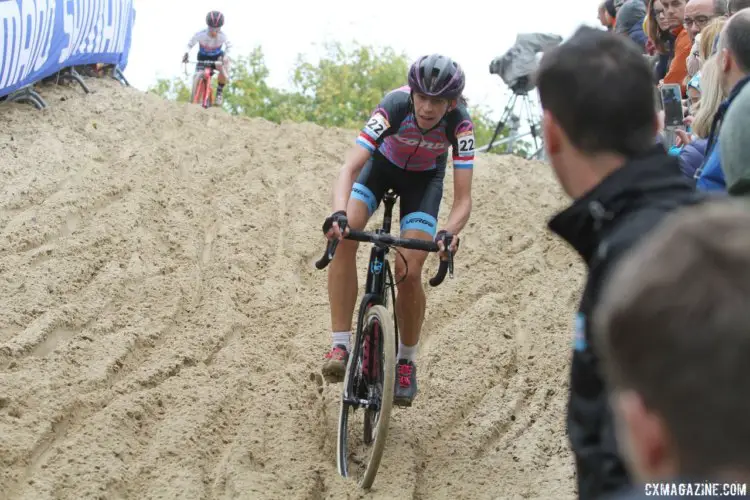
Riding the sand can be a great way to practice low-cadence efforts in tough conditions. Helen Wyman (Kona Factory Racing) navigates the treacherous sand. 2017 World Cup Koksijde. © B. Hazen / Cyclocross Magazine
Also, I think the gym is underutilized as a tool before Nationals. Another scenario that we most likely won’t deal with this year would be excessive heat or humidity. If coming from a dry climate like Colorado to a humid East Coast race, you may want to do some of your weekly workload in a humidified room in your house. Get creative.
The ultimate goal of these approaches is to replicate the demand placed on your body as close to the race environment as you can. The biggest mistake I see athletes make is overtraining leading into Nationals by focusing too much on building the biggest engine possible and not on going in properly rested and healthy. You can have the biggest engine in the world, but if you are running on empty, the effects of environmental factors are going to be amplified exponentially.
With a month between the end of most local scenes and Nationals, getting sick is a possibility.What advice do you have for managing illness before Nationals (or any big race)? Have any guidelines for when it’s okay to still work?
KL: Walk around with a gallon jug of water and drink water like it’s a job. Buy Oil of Oregano in a dropper bottle and take it every other day. This is my secret number-one remedy to ward off illness when form and power-to-weight are at peak levels, which is always a precarious razor’s edge.
Take a Vitamin C supplement every day. The moment you feel a sore throat or sickness creeping in, suck on Cold-Eze lozenges, one after the other. I would recommend emptying the bag into your pocket and consume them all day. This is ultimate IV drip of zinc into your body, will stop a cold in its tracks. Make sure to have pre-ride and post-ride meals, stay hydrated through the day and get to bed EARLY. These are the three best things you can do for yourself.
If you are sick, or are even feeling something coming on, my advice is: When In Doubt, Leave It Out. As noted, the hardest thing for an athlete to do is REST, and as a coach and professional who understands training approaches and peak performances, I have an objective guide: once you get a whiff of infection of sickness, you must rest and relax. Make hydrating and fueling a job.
Many athletes make missteps here and still train through, or kinda-sorta do the workouts. These workouts are not only accomplishing nothing, they are wasting time and setting recovery back. I have seen many athletes destroy peak races and seasons because they trained through illness. All the hours and days are connected, and they add up fast.
Athletes who simply rest and recover while sick come back like lions. The body is producing all these white blood cells to get healthy, and when you have a rested body with raging metabolism good things happen. Especially for cyclocross, you’ll come back with a lot of spring in your pedal stroke. A huge part of peaking for an event is resting properly and allowing the process of super compensation to occur. It’s counterintuitive, but sometimes getting sick and resting is the best thing for an athlete weeks out from a peak event.
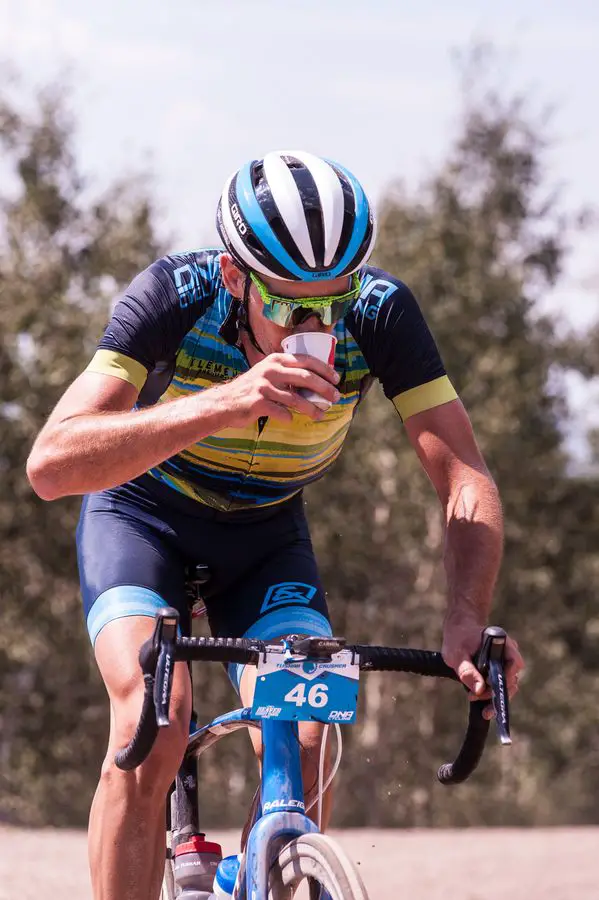
Stay hydrated! Jamey Driscoll finished just off the podium in fourth. 2017 Crusher in the Tushar © C. See
BD: This touches back on simply paying close attention to your workload. If you are self-coaching, then be sure you are getting as much QUALITY sleep as your schedule allows. Note I said quality!
Avoid a lot of hand-shaking and being in close contact with small children, who are exposed to a lot of germs via daycare and holiday gatherings. Also, try to time your workouts so you aren’t around anyone that could get you sick immediately following your workouts. Your immune system is taxed every time you stress it via training and the bigger the training stress the higher the risk. This is why a lot of pros get sick this time of the season. They are pushing every “control knob” to the limits — workload, diet, stress, etc.
If you do find yourself managing sickness on the precious weeks leading up to Nationals, there are some key things to look for in an effort to gauge whether training will be productive or destructive. If you have a fever, then rest is undoubtedly the prescription. When working with clients with a head cold, I will work with them day to day, checking in and focusing on the “meat and potatoes” of each day’s workout. For instance, if they’re supposed to do intervals that day followed by some endurance or tempo riding then we would trim it to just a straight up warmup-intervals-cooldown workout, potentially even doing it on the trainer if weather will be counterproductive to our end goal, which is to have the best CURRENT fitness and form we can.
I emphasize that last point because many athletes have this idea that they will see major gains if they do major work. If you are used to a 10 to 12-hour workload during the season and going to 20+ hours per week leading into Nats will do nothing but dig a hole you cannot recover from in time to see the gains.
CM: I think everyone is kind of managing symptoms right now. Cold, dry air is hard on the sinuses as is having the heat on. Manage those conditions as best you can with humidifiers, hot showers and staying hydrated. From there it’s almost a case by case basis. I can ride pretty well with a cold, but maybe you can’t. I get felled with a lot of sinus infections, maybe you don’t.
Be honest with yourself about what you can and cannot do, with a bias towards not making things worse. Don’t be afraid to take a day off now so you’re not forced off the bike for a week down the road. Fever is a no-go for riding, as is anything below the neck. Even for a sinus infection, I like to take a day or two off to let the worst blow over. And of course, be very aware of the meds you are using to treat your symptoms, as there may be USADA issues.
What about avoiding weight gain and generally bad eating habits during the holidays? Is it possible? Thoughts on logging food and exercise?
BD: Depends on your goals. Your energy expended on this should match your expectations. If you are racing to win your respective category at Nationals, then measuring portions and tracking micro and macronutrients via MyFitnessPal or another diet app is warranted. As I often say, “what gets measured gets managed.” If you are racing singlespeed Nats in jeans for the experience and are prepping more for the afterparty than the race, then don’t add stress to your plate. I will say that monitoring your nutrition is best done from the mindset of “am I fueling adequately and with quality in check” versus “I need to eat less.”
CM: What I would tell a client is “can that s***.” You’re training hard, you need fuel. And your amateur glory does not supersede being nice to people, especially family. Logging food may help keep you stay honest. I find it incredibly frustrating to try and figure out portions and ingredients on anything that’s not in a package, which is the opposite of what you want to be eating. Don’t be hard on yourself during this time of year, it’s incredibly hard to be an amateur and train this time of year.
I would encourage you to eat as much protein as you can. You need carbs for fuel, but I think most athletes have a hard time getting the roughly one gram per pound of body weight they should be getting. And protein is more satiating than most carbs, so feel free to load up on meat and other proteins. Eat all the turkey you want!
I would also add that a lot of people conflate “I want to go faster” with “I need to lose weight.” I don’t think that losing weight will always make you faster, especially in cyclocross. And losing weight often ends up being a justification for cutting calories, which does not make you any faster if you are below replenishment levels. If you want to get fast, fuel to get fast. And don’t think that five pounds are what’s between you and a top placing. I bet ten watts on your threshold or a slightly better run are.
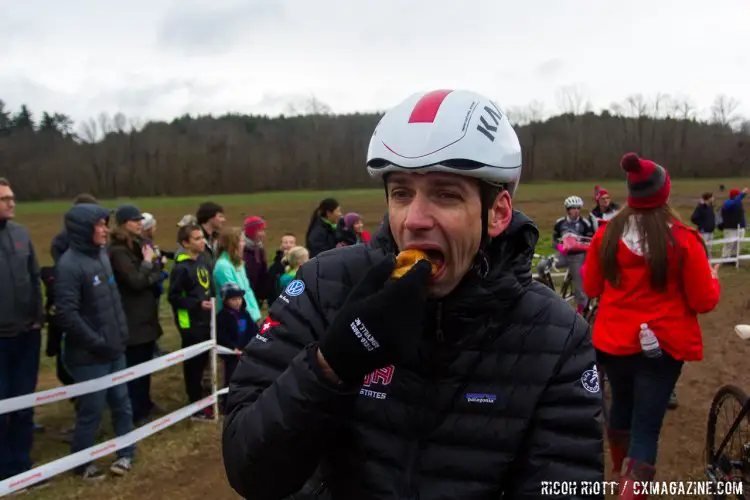
Maybe donuts are not the best workout fuel, but a few sweets over the holidays are not going to destroy your Nationals race. 2016 Cyclocross National Championships. © Cyclocross Magazine
KL: For athletes who are aiming for Nats, this should not be an issue. I am not a hand holder or cheerleader, I don’t need to create motivation. For athletes needing inspiration, I would say to keep reminding yourself the timeframe is very short. Thanksgiving to Nats is 6-7 weeks. Hanukah and Christmas is 3 weeks. Relatively speaking, It’s nothing. The sacrifice is well worth it if you want to win. If you do not prepare 100%, you are not going to Nats to win, you are just going, which is okay as long as you are honest with yourself.
Diet is one thing we have full responsibility over. You cannot control how fast you will be, how the track will ride, how cold it will be, what the conditions will be, if you will wake up sick, if your chain will snap, if you’ll get cut in the third turn. These things you cannot control. However, diet you have 100% control over, and it’s something many athletes don’t respect. Most races have a 12-14 mph average speed, so superior power-to-weight is what gives an edge in this game.
Eat for purpose, not pleasure. Do you want to find your best on race day? Because you will not if you don’t find your best now during preparation. If you’re hungry, drink a glass of water. If you’re still hungry, drink another glass of water. Still hungry? Chill lemon water.
Athletes should be restricting portion sizes but still eating in the same manner for six to eight weeks pre-race. Your metabolism will be through the roof, your VO2 will rise and your body will shred out. Six to eight weeks, erring more to six weeks is optimal for build and timing.
What advice do you have for avoiding mental burnout between now and Nationals?
CM: I’m of a few minds on this. If you’re going to Nationals, then you sort of asked to train at a dismal time of year. So if by burnout you mean a loss of motivation to train, I’d say don’t wait for motivation, get some discipline. That’s a pretty Jocko Willink answer though.
If by burnout you mean a loss of performance in training or other significant changes — poor sleep, weight gain, any sort of “itis” — then you need to evaluate both your training load and your recovery from that training. A lot of athletes under-recover rather than overtrain and that often leads to burn out. These sorts of things are a clear sign you’re not on the right path.
Lastly, can you make it fun in any way? How can you vary your indoor workouts to be more engaging? Can you find a way to re-arrange your waking hours so that you can ride outside? Can you ride at night with friends? Look for any and every small tweak you can make to alleviate the monotony of winter training.
It’s really about a bit over a month or so from the end of the season to Nationals. That’s not that many workouts. Me, the coach from the South, is fond of saying “I could stand on my head in a bucket of s*** for that long.” Figure out your workouts for the block. Focus on doing that one workout right, that day, and recovering from it. And then start marking them off your calendar one at a time. “Ten workouts to go, nine workouts to go …”
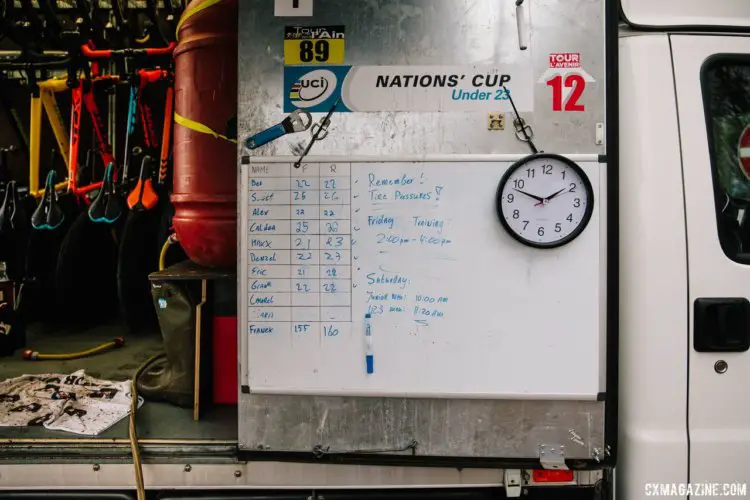
If you need to, plan out your Pre-Nationals workouts and count them down. 2017 World Cup Zeven Course Inspection. © J. Curtes / Cyclocross Magazine
KL: There are no last-minute fixes. Peaking for Nats is a year-long process. If you are getting burnout now, something went wrong during the year. Athletes who have prepared correctly should be salivating to live cleaner through the holidaze to ensure peak performance at Nats.
I advise Less Is More. The work is done. November and December should have been huge months and the diamond is already hardened. Look yourself in the mirror every day, speak your goals out loud, commit to a clean diet, don’t miss a workout or rest day, make sure to stretch one to two times a day, typically post-ride and at some point before bed. You can link together 4-5 stretches, do 2-3 supersets, 10-15min each session. Stretching improves blood flow to muscles and longer, looser muscles are stronger muscles. This extra work will help enhance peak effects and confidence levels.
The one thing athletes can’t do is rest. I am adamant about tapers. You want to find your best in competition and not leave your best in preparation and training. You are on a journey forward and you will find your best at Nats — make it that way.
Better diet. More time off your feet with legs up. More rest. More water. More sleep. Make sure to find 100% sharpness and focus during workout time. This is why you work hard, for moments like this. Embrace this time, you will look back at these years forever.
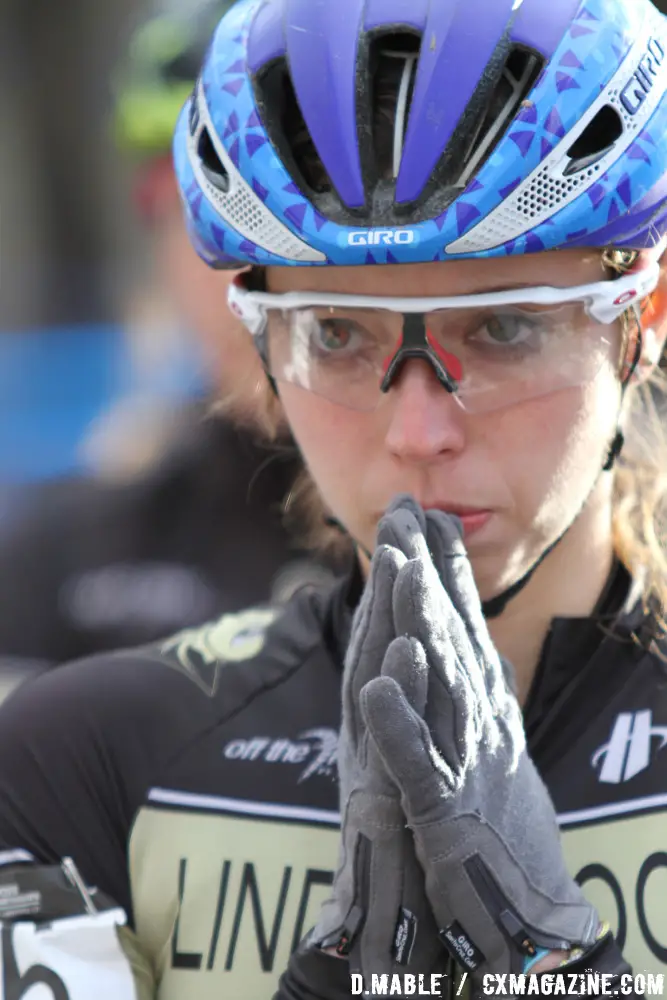
You prepare all season to be ready for this moment. Hannah Finchamp visualizing the victory to come. 2017 Cyclocross National Championships, Women’s Collegiate Varsity Race. © D. Mable / Cyclocross Magazine
BD: This is a case-by-case for sure, but mental burnout can be defeated. You have to look at your season and how you are gauging success and failure. That said, I recommend diving into some motivational podcasts and/or books. Try not obsessing over everything. Lay out a plan of preparation so you aren’t stressing out over details.
For example, try to make a list of everything you need to do leading up to leaving for Nationals and then divide and conquer. If you’re fortunate to have a supportive spouse or partner, then it’s even better. The best defense is not overtraining and getting QUALITY recovery between workouts. In the words of Jocko Willink, “motivation will fail you, discipline won’t.” If you are disciplined in both training and recovery, mental burnout becomes a result of the lack of discipline not motivation.
With so many good riders heading to Nationals, riders can face the new challenge of an undesirable call-up spot. How do you advise racers on preparing for the challenges of a unique race like Nationals?
KL: STARTS STARTS STARTS. Master your start. Practice it a few times every week so the movements are intrinsic. Set your pedal flat at the engagement point, know exactly how you keep your foot on the ground, use the same hand placement, gearing and everything else 100% the same every time. For the start, either stay seated or stand and find the pedal instantly, power into gear and shift when spinning out.
Repeat your start drills in warm-ups, to start intervals and as loose-form drills to warm down. You can do easier reps on recovery days. Master the start mechanics and become very good at hard starts and you will more often than not get into the top group after the holeshot. Another tip is to practice starting in a bigger gear. You will adapt and start faster, allowing you to carry more speed through the early part of the course. Train it and get used to it.
Also, prepare yourself mentally for the hardest race ever. Nationals is the biggest prize and has the hardest competition. You will be at your best and expect to push to new levels, find something new and persevere through the toughest adversity. If you are mid-pack after a lap, keep on the gas and have confidence in your skills and form. You are going to keep knifing forward.
All that matters is how the race ends, not how it begins. #KnowThat #NeverPanic
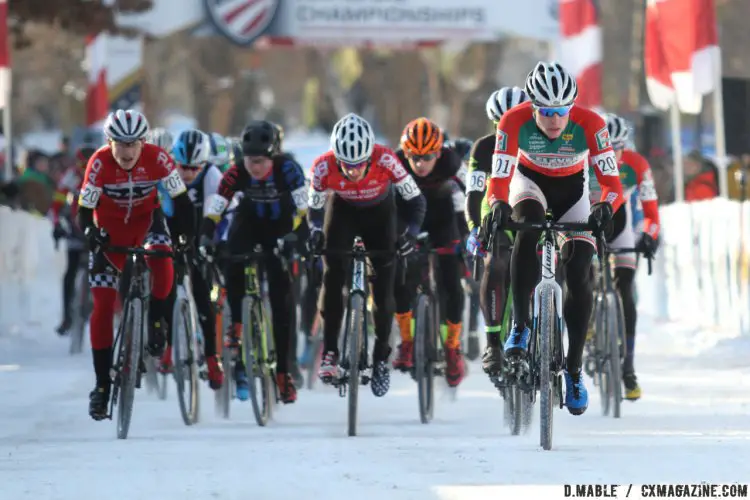
Practicing starts will have you ready come race day. Denzel Stephenson got the holeshot. 2017 Cyclocross National Championships, Junior Men 17-18. © D. Mable / Cyclocross Magazine
BD: Simple … control what you can and don’t waste precious energy on hypotheticals and what others are doing. You do you and focus on bringing the best YOU to the line. You can’t control the weather, call-up spot, the rider in front of you nothing.
An example is Spencer Petrov [in the U23 race] at Pan-Ams this year. He was as dialed as he’s ever been on controlling everything he could and then his chain snapped. I would be willing to bet nine out of ten people would have called it at the start/finish straight and walked off course. He pushed out the hardest effort of the day, coming from minutes off the back to finish top ten. That mental fortitude doesn’t just happen, it’s honed. Adversity can be practiced. If you don’t like racing in the rain, train in the rain. If you don’t like to run, run. If you don’t like ice cream…. well then I can’t help you.
CM: The main tip I would give you for next year is always line up at the back during ’cross practice starts. That way, it feels like the norm and you will be used to working through traffic. The only time I am not a few rows back is at races (unless I get a bad call-up, then that practice helps!). That’s hard to simulate this time of year, but keep drilling those practices. That’s a perishable skill and the better you are at it, the less it’s a weakness.
Learn to ignore everyone around you. That’s hard, I know. But you can’t do anything about them. Your front wheel is your responsibility, so don’t put it anywhere that someone else can take it out. Beyond that, don’t fixate on those around you. Focus on picking the best lines you can, both around people and through the terrain, and the rest will take care of itself.
It’s cold and nasty out in many parts of the country. Is it too late or risky to hit the gym and add some new activities like weights or yoga to stay in shape before Nationals?
BD: Not at all! With many local series finishing in November or early December, getting a solid block of strength training in can yield major gains in power and lean mass. I have a deadlift build block I like to incorporate this time of year. It is a case-by-case basis. If you have been racing hard and not doing core maintenance, then it can be tough but not impossible. Your workload is always individualized, but a good two days a week in the gym up through the week before Nationals can yield big results and aid in weight management provide help for those looking for marginal gains.
CM: Any novel stimulus is going to result in soreness, especially if it involves eccentric contractions. By that, I mean lengthening the muscle under load. Cycling has very little of that type of movement. Running on flat ground has a lot and weight lifting can. So while I’m a huge proponent of CrossFit, it’s not something I’d recommend before a key event. If you’re smart about yoga it can work wonders for you. But if you’re going to yoga as a workout it could result in a lot of soreness.
If you have been running, maybe add a little bit more to your runs. I would advocate adding some more reps to your runs while keeping each rep pretty short. Sprinting tends to maximize your natural shock absorption via your stride, so it should leave you less sore. Running uphill does the same thing. If you have a local hill you can run up, or stairs in a building, I’d encourage you to use those locations to train.
So, yes, I think it’s a bit late to add anything really new to what you’re doing, unless it’s the easiest of yoga classes. Beyond that think about how to train smart with what you’ve already been doing.
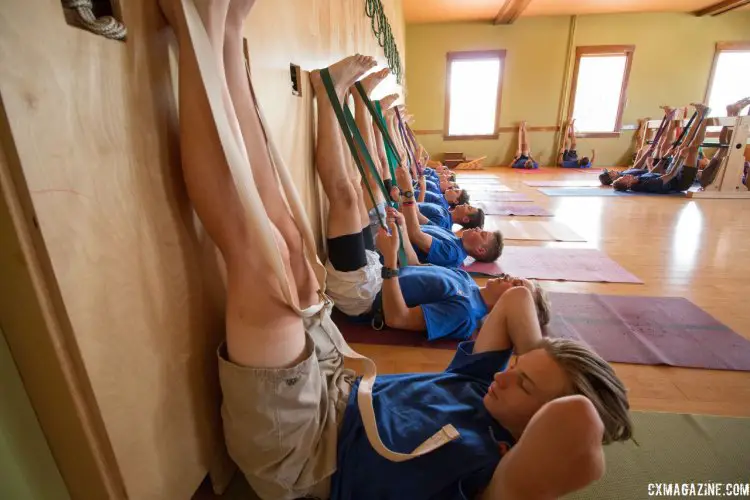
Been doing yoga since summer? Stick with it through Nationals. 2017 Montana Cross Camp moments. © Cyclocross Magazine
KL: I advise not doing anything drastically different in the three weeks before a big race like Nationals. The diamond is hardened, you just need to dust it off. This is the easy work, realizing the fruits of your labor. New activities can risk failure or injury and can really wreak havoc with your confidence. Committed athletes and champions should not need to add new things to their preparation in last weeks. The taper is the best part. The proprioception is set. Trying to teach yourself new things at last moment can diminish peak potential.
Having said that, I don’t believe in superstitions, just superior preparation. I have coached athletes who love doing light gym workouts as active recovery workouts, because of work or training availability, but this is something they do all year. The main thing is to not deviate from your plan and add new things haphazardly in the final weeks.
You should have everything planned out. Now is time to rest, enjoy and visualize a winning performance. #HappyHolidaze #ChampionBehavior
Cyclocross Magazine will be in Reno to cover all Championship racing from January 10th to the 14th. We wish everyone racing at Nationals the best during the rest of their prep. Thank you to our coaches for offering their expertise to help everyone be on top form.























